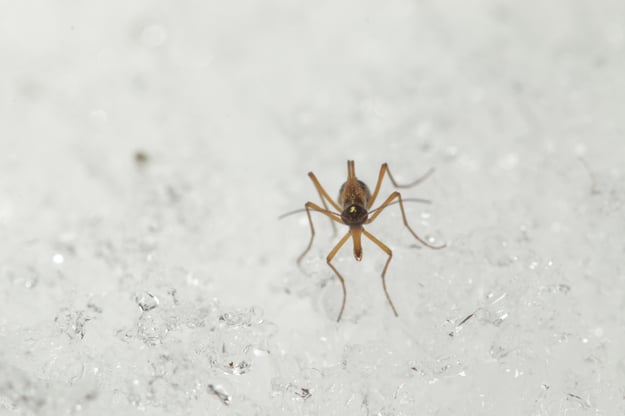In the frigid landscapes of the Northern Hemisphere, a resilient and often overlooked insect species thrive – the snow flies, scientifically known as Chionea. You may have seen these small insects crawling directly on the snow surface with their 6 long spindly legs. These remarkable creatures have evolved unique adaptations to endure the harsh conditions of cold environments and have developed intriguing mating strategies to ensure their species' survival.
Winter is a challenging time for all living things. Most insects are not able to maintain themselves in below-freezing temperatures. Once an insect begins to freeze, they are ‘supercooled’ and their bodies freeze incredibly rapidly. As a result, during the winter insects have a variety of strategies to help them survive. Some insect species will overwinter in an egg, larvae, or nymph stage until the spring comes. Some insects will migrate to more favorable climates. Still, other insects go into a dormant in a hibernation-like state in which they are entirely inactive. However, snow flies have a unique ability to be active in below-freezing temperatures. So how do they do it? Why are they even active in the winter?

Snow Fly Image Close Up
The lifecycle of snow flies is not well understood. Snow flies are most easily found on top of the snow, they can also be found on the ground, under leaf litter, logs or rocks, and in mammal burrows. They prefer temperatures just below freezing and they can live for about 2 months in their adult form. The adults have 6 long spindly legs and no wings. It doesn’t appear that adult snow flies eat, but they have been observed drinking water and maple syrup in lab settings. The main focus of snow flies adult life is to find a mate with which they can reproduce. Two potential advantages of searching for mates in winter are the uniformity of the snow and the absence of predators.
Adult snow flies have been observed moving around active at temperatures around -10C (14F). At these temperatures, snow fly limbs are at risk of rapid freezing, called supercooling, which can quickly spread to the main body, and kill the insect. The median time for ice to form across the entire snow fly leg is only 533ms. So how do they prevent the fatal propagation of ice across their body? Self-amputation. Once the limb is frozen, snow flies take about 2.5 seconds to self-amputate the limb. If done quickly enough the main body of the snow fly remains unfrozen and the insect can continue living and searching for a mate.
Self-amputation is not unique to snow flies, many other animals are known to self-attribute to survive challenging situations. Insects like earthworms, spiders, scorpions, centipedes, and crickets are known to self-amputate tails or legs to survive. Lizards (geckos) and salamanders can drop their tail if caught by a predator. This trait also extends to aquatic organisms such as squids, jellyfish, and sea stars. These organisms use self-amputation to escape a predator. The snow fly is the only known case of a living organism self-amputating to survive the cold.
Spring is a great time to keep an eye out for snow flies. They are crawling around on the snow surface, often at higher elevations near treeline. You can report snow fly observations on the app iNaturalist and help document when and where we see the adults in Colorado.
Riley Gaines is the Community Science and Hiking Coordinator at Walking Mountains. He leads backcountry hikes, snowshoes, and tries to encourage the community to collect data for scientific research projects.







